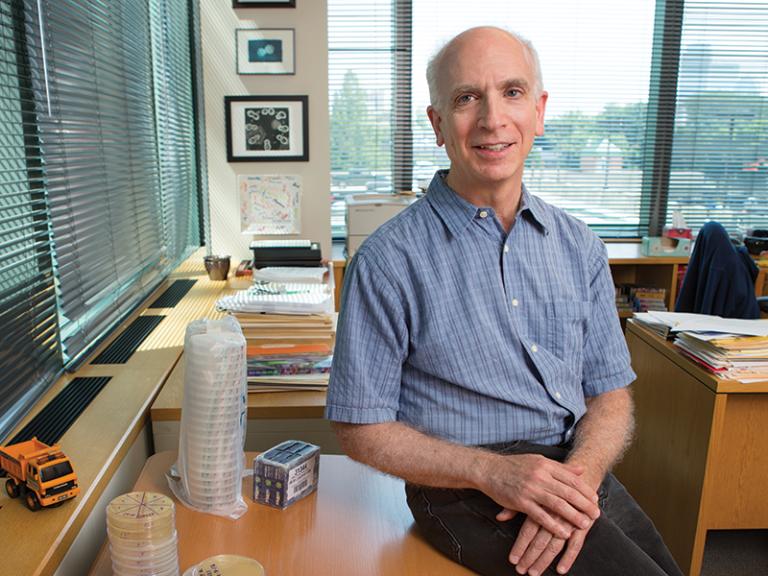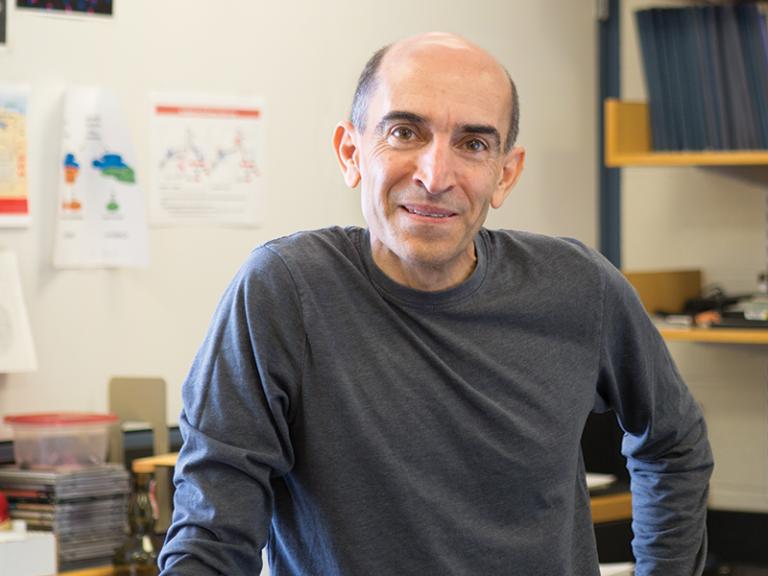After Effects
Scientists study how epigenetic mechanisms work
- 12 minute read
- Feature

The chemical was everywhere: in water bottles and children’s sippy cups, dental sealants, and the linings of food cans. It was detected in the urine of more than 90 percent of the people in this country and suspected of causing markedly decreased fertility rates in workers in the factories that made products containing the chemical. Animal studies added to the grim litany: the chemical disrupted endocrine hormones and may have caused health problems from cancer to heart disease to impotence and low fertility.
This pervasive chemical was bisphenol A, commonly known as BPA, a substance that the U.S. Food and Drug Administration considered safe, even as it opened an investigation into its effects on human health in 2008. In its 2014 update on the chemical, the agency still listed it as safe for humans when used in the levels found in food packaging.
Yet many scientists, including some at HMS, have expressed skepticism over the generally recognized as safe designation. Animal studies, after all, had found not only that BPA was damaging to organisms exposed to it, but also that it could affect their offspring. In short, researchers said, the chemical’s damage appeared to be inherited.

In the past decade, many scientists have attempted to further our understanding of how environmental exposures affect our long-term health. Doing so has proved difficult. Take BPA as an example. The chemical’s presence in such a large percentage of the population makes designing rigorous, controlled studies a daunting task. Animal studies, therefore, take on a greater empirical role even as some people question whether findings in animals are useful representations of human health. Furthermore, in the research community, there is some disagreement over which biological mechanisms are affected by environmental influences and how these changes occur at a molecular level. Then there’s the big question: How big a role does the environment play in human health risk?
Currently, a growing body of research that seeks to shed some light on these questions is delving into what is known as the epi-genome, an intricate system of molecules that interact with an organism’s DNA. It is one of many strategies employed by cells to control gene expression.
Traffic Control
While DNA is the complete instruction manual for building an organism and keeping it running, the epigenome is one of the several mechanisms used to control which of those instructions should be followed and when. This orchestration aids in the formation of tissues and organs during development and the timely production of proteins during an organism’s life.
Epigenetic changes do not affect genes directly, as genetic changes do. Instead, they operate on “top” of DNA, not within it, as mutations do, and cannot rewrite the information that a gene encodes. When the genome is replicated during cell division, epigenetic marks, the molecules that label genes to be switched on or off, are sometimes copied and preserved alongside the genes they control. In such cases, the changes become heritable.
Molecular Mechanics
Fred Winston, the John Emory Andrus Professor of Genetics at HMS, has spent decades studying genetics and epigenetics in yeast and has watched the field of epigenetics gain prominence. For some time, Winston says, there has been one acknowledged epigenetic mechanism: DNA methylation.
The work that helped identify that key mechanism dates to the mid-1970s, according to a 2014 report in Cold Spring Harbor Perspectives in Biologythat discusses the field’s history. Around that period, scientists began proposing that DNA methylation, a natural process in which specialized enzymes attach a methyl group to a gene, may act to prevent a gene from being transcribed, effectively turning it off.

This control process, it was found, could sometimes be influenced by chemicals from the environment, which themselves add methyl groups or, in some cases, act to remove methyl groups that keep a gene quiet. Because some of these epigenetic marks persist over an organism’s life, DNA methylation is a mechanism proved to be heritable.
Another epigenetic mechanism described in that report is histone modification, which acts by altering the physical structure that houses DNA. In cells, DNA spools around histone proteins. Chemical groups, including methyl groups, can attach to the histones and either activate or repress transcription, depending upon the particular modification. Although scientists in the 1950s were already proposing that histones may act to repress gene expression, direct evidence of how molecular changes to histone affect gene expression was not documented until the 1990s.
As the field has matured, additional mechanisms for epigenetic changes have been described. In the HMS laboratory of Scott Kennedy, for example, work with Caenorhabditis elegans, a millimeter-long transparent nematode, has shown that epigenetic information can be inherited via a nuclear RNA interference (RNAi) pathway that uses noncoding RNA as informational vectors capable of transferring gene-silencing information over generations. In written material describing his work, Kennedy, the Philip and Aya Leder Professor of Genetics at HMS, notes that the findings from his team of investigators have led them to propose that animals may “use the nuclear RNAi machinery to transmit epigenetic information, accrued by past generations, into future generations to regulate important biological processes.”
Such discoveries are promising for the field and for efforts to understand environmental effects on gene expression and development.
“There are a lot of epigenetic factors we’ve known about for a long time, but their real roles are still poorly understood,” Winston says. “Now, as technology has advanced, we’re able to study responses to environmental stresses in microorganisms under many different conditions. This is very exciting.”
Early Action
Monica Colaiácovo is one HMS scientist who is trying to solve questions of how organisms respond to environmental stresses—questions that immerse her in work that is helping to describe epigenetic mechanisms and the heritability of epigenetic changes. When the FDA began looking into BPA’s effects on humans, for instance, Colaiácovo was one of the many researchers across the country who became curious about the chemical’s potential effects on humans. Colaiácovo, an HMS professor of genetics, studies reproduction in C. elegans, focusing on meiosis, the biological process that results in egg and sperm cells with genomes that vary from the parents’ genome, so BPA’s observed effects on human fertility and reproduction interested her. How, she wondered, might the chemical affect meiosis?

In her 2010 paper in the Proceedings of the National Academies of Science, Colaiácovo showed that BPA had grave effects on fertility and reproduction. It caused sterility, prevented the creation of genetically healthy egg cells, and increased the likelihood that embryos would die. The chemical, she realized, changed the expression of genes in C. elegans. The findings were so sobering that Colaiácovo became concerned over the health risks of environmental exposure to other chemicals that were considered safe by regulatory bodies like the FDA.
“So many chemicals are introduced into our environment every year,” Colaiácovo says, “but we have little understanding of their effects on our health.”
Although the human body has ways to eliminate toxic chemicals so that their immediate health effects are limited, studies suggest that some of the changes these chemicals may cause to the epigenome are maintained during cellular replication throughout an organism’s life. Even a brief exposure to a harmful chemical, says Colaiácovo, may cause epigenetic changes that last long after any traces of that chemical have disappeared from the environment.
Environmentally induced changes in genome expression may be especially damaging during pregnancy and early childhood, and could fundamentally alter a developing infant, causing learning disabilities, brain abnormalities, and metabolic imbalances. Children are at higher risk for developing problems from such exposures, Colaiácovo says, because their bodies metabolize chemicals differently from how adults do in some cases, breaking them down more slowly, or in other cases not metabolizing them at all, allowing certain chemicals to linger longer and do more damage.
Furthermore, because the epigenome plays a critical role in prenatal development, its disruption can be ruinous to potential offspring. Cells use chemical signals to communicate and coordinate epigenetic regulation of organ development and tissue differentiation. Exposure to the wrong chemical signals, such as those introduced from the environment, can subvert embryonic development.
The Big Picture
Determining which mechanisms drive epigenetic change and how they do so are not the only questions being investigated in the field. Researchers such as Chirag Patel, an HMS assistant professor of biomedical informatics, are working to find and replicate associations between environmental exposures and disease using human population data sets.
According to Patel, the tools epidemiological researchers can use to identify the environmental contributions to disease are less advanced than those available for determining a disease’s genetic components, making it more difficult to pinpoint environmental links to disease. Despite this paucity, a growing body of research indicates that environmental factors may play a major role in many diseases, including cancers, diabetes, and heart disease.
Investigating disease-environment associations requires Patel’s research team to piece together data from national health surveys, health insurance data, and disease and pharmaceutical registries. The team’s findings can be used by other researchers to prioritize experiments to determine whether an association is coincidental.
Correlations can be misleading, Patel says, so his research team uses several strategies to eliminate false associations and biases, including replication of findings in multiple sets of individuals; elucidation of the timeline of associations—did the chemical exposure appear first or did the disease—and encouraging other researchers to confirm findings with animal studies or laboratory analyses. Recently, his team has begun using twin studies to separate genetic and environmental causes.

Reproducibly associating chemical exposures with epigenetic changes and their health consequences requires population data that researchers typically don’t have, says Patel. Epigenomic sequencing, which entails recording the methylation states and other epigenetic marks alongside both the genome sequence and environmental exposure information, is not common yet. Because of this, says Patel, there have not been nearly as many environment-wide association studies as genome-wide association studies.
“We’ve had some debatable evidence that some environmental exposures are correlated with changes in the epigenome,” Patel says, “but I think what is missing in this field are methods to deduce causal connections.”
Self-Correcting?
There is a spirited debate over what defines an epigenetic change and the extent to which epigenetic changes are truly heritable from parent to offspring.
When epigenetic inheritance was first proposed, it reopened age-old debates about evolution. Before Charles Darwin put forward his theory of natural selection, another nineteenth-century scientist, Jean-Baptiste Lamarck, was advancing a different theory. Lamarck espoused the inheritance of acquired characteristics, in which organisms could pass to their offspring traits that the parents had acquired during their lifetime. Thus, according to Lamarck, if a giraffe, for example, kept reaching for the leaves highest on a tree, it would give birth to offspring with longer necks.
When genes were discovered, scientists saw that their function fit more closely with Darwin’s theory. An organism’s heritable traits resided in its genes and were determined before it was born. Later, when the epigenome and its role were discovered, scientists realized that the consequences of exposures during an organism’s lifetime may be inherited by its offspring after all. The epigenetic mechanism was more limited in scope and not malleable by behavior as Lamarck envisioned, but it did challenge the modern understanding that genes were the sole carriers of inheritance.
Although many organisms, including nematodes, retain and pass along epigenetic marks from environmental exposure, human egg and sperm cells undergo extensive reprogramming during development. This reprogramming erases nearly all epigenetic marks.
The existence of this reprogramming function has made Danesh Moazed, an HMS professor of cell biology, skeptical of transgenerational epigenetic effects in humans. Moazed studies the regulation of gene expression in yeast and mammalian cells, including how epigenetic marks are maintained in yeast, an organism that has transgenerational epigenetic inheritance.
Moazed says that one of the important purposes of epigenetic reprogramming in human sperm and egg cells is to eliminate epigenetic changes that might be caused by the environment. The mechanism evolved, he says, to prevent environmental perturbations from being transmitted across generations. Mammals also seem to lack an RNA-based system that can transmit information from somatic cells to gametes seen in some invertebrates.
Moazed acknowledges that the chemicals pregnant women are exposed to can affect their offspring and that environmental factors can modify already-formed egg and sperm cells. But he does not think there is sufficient evidence showing true parent-to-offspring epigenetic inheritance in humans or most mammals. Instead, he says, effects in humans thought to be caused by transgenerational epigenetics are really examples of prenatal environmental exposure.
“Can epigenetics cause changes that could be stably transmitted for many, many generations?” Moazed asks. “Yes, in most extant life, but probably not in mammals.”
The Long View
The extent to which chemicals in our environment can cause lasting, transgenerational epigenetic changes may be uncertain, Colaiácovo says, but she adds that whether transgenerational effects are a matter of true inheritance or simply of prenatal exposure, the health effects for future generations will be just as real. She points to the similarity between epigenetic mechanisms in nematodes and humans and to the consistency that exists between her lab’s findings and observed effects in mice and humans. Colaiácovo thinks the outcome of her research in nematodes will illuminate the lasting health risks caused by the profusion of unregulated chemicals people are exposed to daily.
The possibility of such transgenerational effects is one of the issues that concerns Colaiácovo and drives part of her research.
Having shown that the effects of BPA during meiosis in nematodes were similar to those in mice and consistent with health problems observed in humans, Colaiácovo has now begun a screen of more than forty common environmental chemicals that are not currently designated as posing reproductive health risks by the FDA. The screen includes pesticides, chemicals used in fracking and crude oil processing, and phthalates, chemicals used in many different kinds of products including some plastics. Colaiácovo is exposing nematodes to these chemicals in dosages consistent with levels of human exposure. She’s not sure what the screen will find, but the health implications could be substantial, especially for any chemicals that show transgenerational effects, given that some of those influences may be the result of epigenetic effects.
“My research into the effects of environmental exposure to chemicals began because of my interest in understanding the biology,” Colaiácovo says, “but as my sisters and I started having children, the work has evolved into something that matters even more. I want to understand what could affect them and my future grandchildren.”
“What are the chemicals that should be more tightly regulated?” she asks. “Are there better alternatives?
If we have the science, we can make these decisions and improve our reality.”
Greta Friar is a Boston-based science writer.
Images: Mattias Paludi (top); John Soares (portraits)